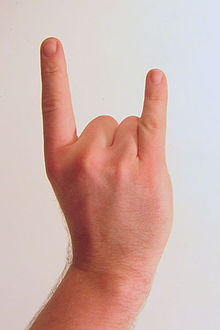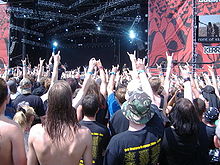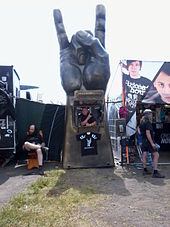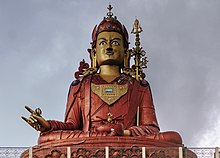Mano cornuta
The corna ( Italian for 'horns') or mano cornuta (Italian for 'horned hand') is a common vulgar gesture in Italy, but also a hand sign with various meanings, for example in the metal and rock scene.
Depending on the meaning, it is also known under the name Teufelsgruß , Satansgruß , Satanistengruß , Pommesgabel , Metalhand and English Devil horns ('devil horns'), goat horns (' goat horns'), hook 'em horns , throwing the goat or metal fork . The earliest known appearance of the horned hand are images on Etruscan tombstones .
gesture
The index finger and little finger are spread apart from the fist while the thumb remains on it. This is very similar to a gesture common in various musical genres, but not widely adopted in Italy because of the possible confusion with the variant there. The hand sign is also similar to the ILY sign of American sign language for the sentence " I love you " ("I love you"), where the thumb is spread out to the side.
Presentation in electronic media
With the advent of e-mail and other text-based electronic communication channels, a left-hand slash , the lowercase m and a right-hand slash are used as representations: \ m / .
In Unicode 8 , Codepoint U + 1F918, a new emoji character (?) called SIGN OF THE HORNS was introduced.
Meanings
infidelity
If the "horns", i. H. the outstretched fingers, secretly shown behind the head of someone or clearly pointed to a person, should convey that the person has been cheated by their wife or husband, ie is a "horned" husband ( cuckold ) or a "horned" wife .
Showing someone the "corna" over their head when a picture is taken is a common joke.
The origin is traced back to the legend of the Minotaur . Pasiphaë , the wife of the Cretan King Minos , had fallen in love with a white bull and the Minotaur, who was born as a result, was the obvious proof of her adultery with his horns.
Superstition
When confronted with unfortunate events, or when these are mentioned or hinted at, the person who wants to avert the unhappiness can fall back on the "downward" corna. In this case the gesture is typically directed downwards, also to distinguish it from the previous meaning "infidelity" (typically directed upwards). It is the popular variant of "knocking on wood". Alternatively, the Italian can “touch iron” ( tocca ferro ). All of these gestures are intended to protect the performer from supernatural evil forces, for example if a black cat crosses the path, a hearse is seen or the person gets into any situation that they believe will bring bad luck.
This meaning is also mentioned in Gaston Leroux's novel The Phantom of the Opera . It says: "As soon as the image of the Persian was conjured up, the ballet performers made the sign against the evil eye by stretching out forefingers and little fingers, while the thumb, middle and ring fingers pressed on the palm."
Italian President Giovanni Leone shocked the nation in 1973 when, on a visit to Naples during an outbreak of cholera , he shook the sick hands with one hand and showed the corna behind his back with the other hand. This act was well documented as all the journalists and photographers were behind it, which President Leone may not have been aware of at the moment. The gesture was particularly interpreted as an insult to the sick.
Metal
Often called simply Metal Sign in English , the ironic expression "Pommesgabel" established itself in the German scene. It is pulled up together at concerts to demonstrate the group feeling, the scene identity and the enthusiasm for the music.
Who ultimately brought the mark into the metal scene is highly controversial. Gene Simmons , bassist for Kiss , presents himself in his autobiography Kiss and Make Up as the originator of the gesture and argues that he can be clearly seen on the cover of Love Gun (1977) with it. In 2017, Simmons filed a patent application for the gesture. However, Simmons' gesture is not about the metal sign, in which the thumb is pressed on the middle and ring finger, but about the ILY sign of sign language, recognizable by the splayed thumb. Simmons withdrew his patent application.
Ronnie James Dio, on the other hand, was of the opinion that he was the first to use the symbol during his time as a singer with Black Sabbath and thus introduced it to the metal scene. Dio is said to have known the sign from his superstitious grandmother, who is said to have used it in superstition (see also above), because it protected her from the evil eye . In the documentary Metal - A Headbanger's Journey he uses the word Maloik for it . He initially used the sign for meaning in passages of text where it was about the devil or evil. After the audience always imitated this symbol and it had also established itself at other heavy metal concerts , it became his trademark. According to the view within the scene, he is therefore also the one who brought it into this scene.
The sign can also be seen on the LP Witchcraft: Destroys Minds & Reaps Souls by the psychedelic rock band Coven from 1969, which also contains the probably first recording of a black mass . Sometimes other meanings are assumed in addition to the assigned meaning of the universal greeting, such as that it is a symbol for Satan , evil or mysticism . In addition to metal , the symbol is also partly used in rock music . Interestingly, however, that the gesture in 1968 by John Lennon on promo photos for album Yellow Submarine of the Beatles was used and also from the Lennon performing cartoon character on posters and album covers for animated film Yellow Submarine is shown - over the head of Paul McCartney performing cartoon character . Elvis Presley used the gesture on October 28, 1956 when he was singing Hound Dog on the televised Ed Sullivan show . At first, Presley only pointed at the audience with his index finger, but later with the said gesture. This scene was later used by Neil Young in his video He Was The King .
The Mano Cornuta has also established itself in other music genres. It is also used in areas such as hip-hop and pop , albeit under criticism from the metal scene. Metal musicians such as Dee Snider from the glam metal band Twisted Sister criticize this. The “wrong” mano cornuta (with an outstretched thumb) is also criticized. Since the meaning behind the symbol is not very well known to many, one recognizes the poser titled by bands like Manowar (people who go to metal concerts without any real knowledge of the music) by gestures like the "wrong" cornuta. The metal scene in particular is known for attaching great importance to its traditions and the friendship that this membership of the scene brings with it. That is why the “French fries fork” is a tradition and forms a kind of “identification mark”.
American Football ( Hook 'em Horns )
For fans of the Texas Longhorns American football team at the University of Texas at Austin (UT), this hand sign stands for Hook 'em Horns . There it was introduced by Harley Clark in 1955. It is designed to recreate the shape of the Texas longhorn bull Bevo, the university's mascot . Since 1916, a bull has been chosen to embody the mascot. Meanwhile, the fourteenth Bevo, who had attended the sports department since 2004 when he was two years old, before he had to be put to sleep on October 17, 2015 after contracting the bovine leukemia virus . The hand sign is often shown at sporting events while playing the school song The Eyes of Texas or the battle song Texas Fight . It is one of the most famous hand signs of all US universities.
Clark got the idea from his colleague Henry Pitts. Clark showed the sign to enthusiastic students a few nights later at a meeting at the Gregory Gym. It was an instant hit - thousands of students raised their arms to show the then-famous greeting. The next day, a UT football game against Texas Christian University, Clark stood in awe as the "Hook 'em Horns" sign billowed from side of the stadium to the other.
Tibetan Buddhism
In Tibetan Buddhism , this hand sign is a mudra , a sacred gesture that is found in the representation of Buddhist beings and is used as a means of meditation. In Sanskrit it is called karaṇa-mudrā and is a gesture of banishment that is used to drive out demons . It is supposed to represent the horns of a wild yak pointing at an opponent. The gesture is usually performed with the right hand, and occasionally with the left hand. The hand position is either horizontal or vertical; the middle and ring fingers are drawn in, the thumb is placed on the middle finger and the index and little fingers are stretched out. The gesture can be seen in depictions of Ekajati and Yama .
Identification mark of the Mara bands
Violent street gangs , the Mara Salvatrucha , arose in North and Central America in the 1960s . In a replica of the letter M, they use this hand sign with their fingers pointing downwards as their most important identification mark.
See also
- Shaka (sign) , a similar gesture
Web links
- Reinhard Krüger: Etymologies of gestures. Fare le corna - the 'horn gesture' . Institute for Literary Studies at the University of Stuttgart
- Dio on the misuse of the horns
- Rock and Roll Confidential on their logo
- Goat skirt
Individual evidence
- ^ John F. Hall (Ed.): Etruscan Italy: Etruscan Influences on the Civilizations of Italy from Antiquity to the Modern Era . Indiana University Press, October 1, 1997, ISBN 978-0-8425-2334-9 , p. 359.
- ↑ See the 1973 feature film Love and Anarchy .
- ↑ Combination of the characters for the letters I, L and Y to "I love you" in American sign language
- ↑ http://www.unicode.org/Public/8.0.0/ucd/UnicodeData.txt
- ↑ The French fork should soon belong to the Kiss bassist
- ↑ Benjamin Pyke: Who does the ILY hand shape belong to? In: taubenschlag.de. September 20, 2017, accessed June 1, 2020.
- ↑ Miriam Mentz: RIP Dio - American rock singer died of cancer at the age of 67 .
- ↑ http://www.derwesten.de/kultur/musik/ronnie-james-dio-der-erfinder-der-pommesgabel-ist-tot-id3518077.html
- ↑ http://www.takebackthehorns.com/
- ↑ Texas mascot Bevo XIV dies following cancer diagnosis (English), accessed March 18, 2016
- ↑ Jim Nicar: Hook 'em Hand Sign - Traditions , texasexes.org, accessed December 30, 2012
- ↑ Fokke Sierksma: Tibet's Terrifying Deities. Sex and Aggression in Religious Acculturation. Charles E. Tuttle Co, Rutland / Toyko 1966, p. 225 (English).
- ↑ Oliver Fülling: Tibet. 2nd, completely revised edition. DuMont Reiseverlag, Ostfildern 2011, ISBN 978-3-7701-6172-0 , p. 338.






